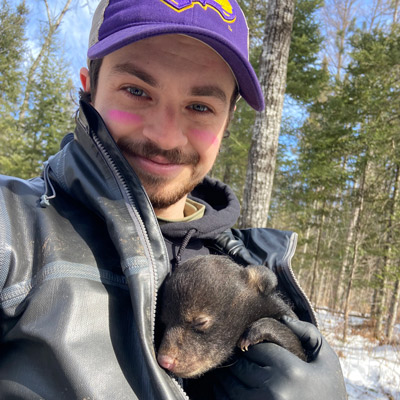B&C Fellow - Hayden Walkush

University of Wisconsin – Stevens Point – M.S. Student in Wildlife Ecology and Management - Projected to Graduate May 2026
Project Title: The Movement and Behavioral Ecology of Black Bears in a Hunted System Turkeys
Growing up in central Wisconsin, I was able to explore the region’s public lands and state parks early in life. My passion for hunting and fishing became my gateway into the world of conservation and wildlife management. The University of Wisconsin-Stevens Point’s (UWSP) College of Natural Resources was practically in my backyard, only a thirty-minute drive from my hometown. Enrolling there was an easy decision, and within a month of arriving on campus I was conducting telemetry triangulations on black bears in the Chequamegon-Nicolet National Forest- the same place where I now conduct my thesis research on black bears. As an undergraduate, I was awarded a B&C research fellowship to study wild turkeys, working alongside a graduate student on projects with direct management implications. I returned to UWSP to pursue my master’s degree and study black bear spatial and behavioral ecology, once again as a B&C research fellow.
The Movement and Behavioral Ecology of Black Bears in a Hunted System
Animal movement emerges from behavioral decisions made across the landscape, and understanding these decisions is critical for linking movement to ecological and management processes. Female American black bears (Ursus americanus) in the Chequamegon-Nicolet National Forest in northwest Wisconsin, navigate a predominantly forested, human-influenced landscape where hunting-related practices, timber management, and habitat features interact to influence space use and activity patterns. But how female black bears adjust their behavior in response to these drivers, and the extent to which they may influence harvest vulnerability, remains poorly understood. Therefore, our objective was to examine the interindividual variation in female bears’ behavioral-state specific (i.e., resting, foraging, and traveling) resource selection, activity patterns, and responses to hunting-related practices. We collected data from 10 GPS-collared females, trail camera footage, hunter-reported hound chase paths, and mapped home ranges. Our analyses will provide insight into female black bear behavioral flexibility and inform future conservation and management strategies.
